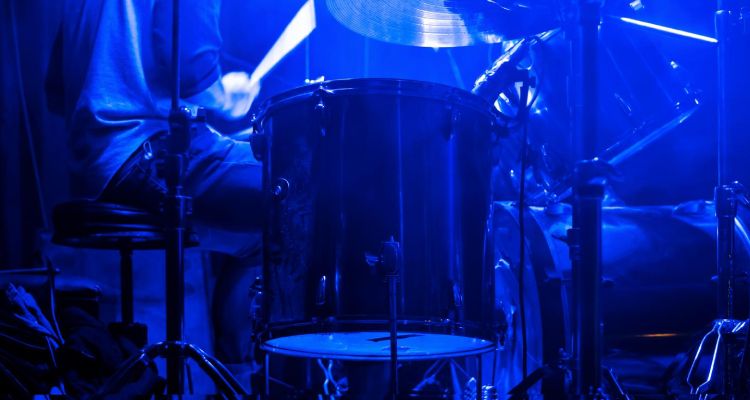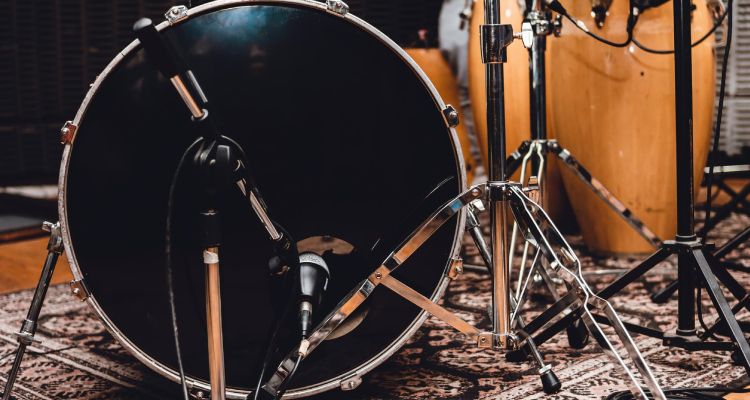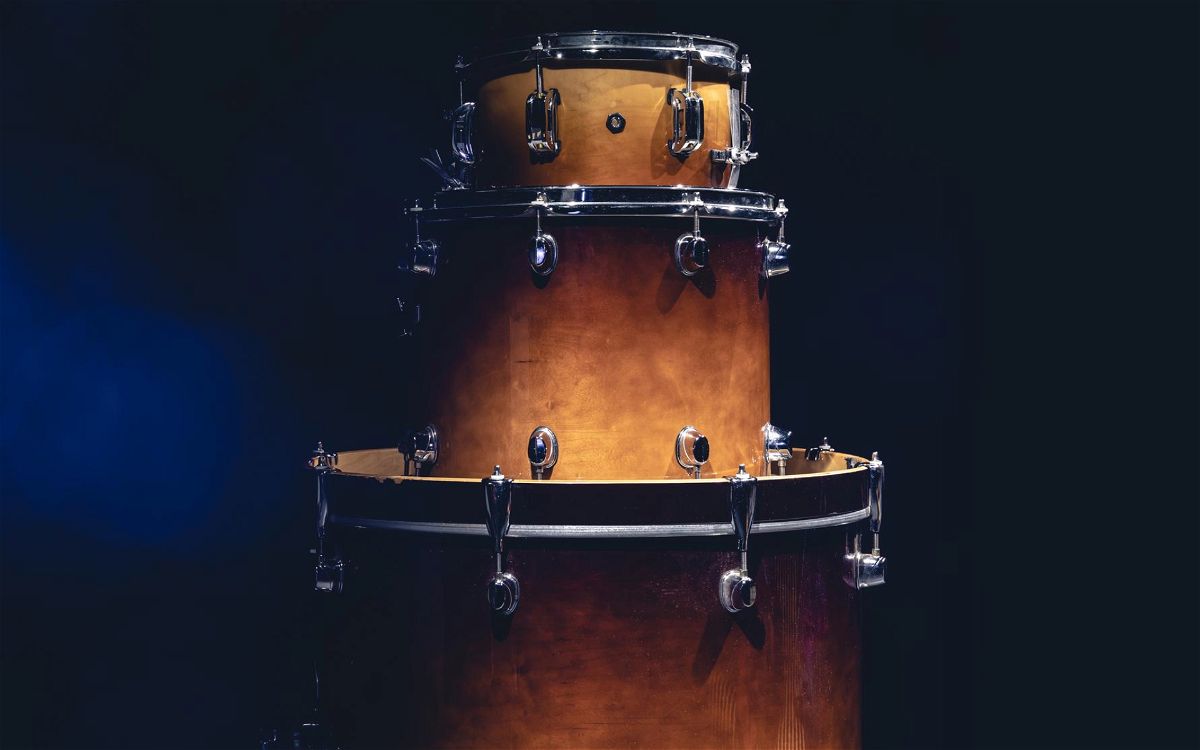When looking to buy a drum kit, tom size is a big factor to consider, as the size of your toms will determine several tonal qualities that you can expect from that kit.
Different drum tom sizes will affect drum sound, pitch, resonance, volume, and overall positioning, so choosing applicable tom sizes may be a bit harder than you originally thought.
In this guide, I’m going to break down each of these things so that you’ll know exactly what sizes to look for to get the sounds that you want.
Contents
Identifying Toms
Rack Toms

Rack toms are the toms that get placed above the kick drum. If there are two of them, they’re commonly referred to as the high tom and middle tom. However, it’s easier to just call them rack toms if there are three or more on a kit.
The main identifying characteristic is that they’re shallow in depth. All rack toms range from depths of 6” to 12”.
Their diameters are also smaller than all the other drums on the kit, ranging from 6” to 14”.
Most drum kit setups will have the rack tom drum size positioned from smallest to largest, but some drummers like to switch it up to add a bit of tonal variety when playing drum fills.
Floor Toms

Floor toms are the drums that rest on legs that get positioned on the floor. Some older floor toms are designed to be mounted to stands, but all modern drum kits have floor toms with three distinct legs.
When looking at diameters, floor toms range from 13” to 18”. Their depths range from 11” to 18”.
A typical 5-piece drum set will only have one floor tom, but you’ll find plenty of kits that have more. Drummers like Dennis Chambers are well-known for using three floor toms in their setup.
Floor tom sizes are always the biggest in a setup, so that’s another easy way of identifying them.
Some drummers like to use floor toms as rack toms, but they’re still considered floor toms in that position due to their large size.
How Size Affects Toms

The size and makeup of a tom play a huge role in how it sounds. The major drum brands design them in different types of ways to achieve various sounds. Here’s everything to know regarding the shell structure.
Tone
Tone refers to the overall sound quality of a shell, and the thickness of tom shells is one of the biggest factors that affect that.
You’ll find thin, medium, and thick shells, and they all offer various tonal qualities.
Thin shells tend to ooze the most tone, as they vibrate more when struck. They’re also very sensitive, meaning you’ll get more fullness of tone when striking them softly.
Medium tom shells vibrate a bit less when struck, and that leads them to sound a bit less sweet, but they tend to be more controlled and louder.
Thick tom shells have the most aggressive tones. They’re very intense, punchy, and powerful. They’re also easy to control and stop any unwanted overtones from coming out.
Pitch
The pitch of a tom mostly depends on the diameter.
The smaller a tom is, the higher its pitch will be. The larger a tom is, the lower its pitch will be. That’s why rack toms always sound higher pitched than floor toms.
When toms are placed in a standard setup on a drum kit, that’s when you get the typical sound of a drum fill going from highest to lowest drum around the set.
You could tune the toms to sound lower or higher, but the tom with the smallest diameter will always have the highest pitch ceiling, while the largest tom will have the lowest.
Resonance
Resonance is determined by the depth of a tom. Toms with deeper depths will resonate more, meaning their tones sing for longer. You’ll hear floor toms ringing for longer than rack toms in most cases.
This is where depth is an important feature to look at when choosing a drum kit. If you want your toms to ring as much as possible, you need to get ones with larger depths.
Toms with short depths are called fast toms, and they’re regularly used by drummers with quick playing styles that fit lots of notes in short spaces.
Just note that the bottom drumhead on a tom also plays a big role in how much it resonates. The tighter it is, the longer the drum will sing for, and vice versa. All the drum kits in the 60s had no resonant heads, and that’s why they sounded so flat.
Projection and Volume
Resonance and volume go together when it comes to toms. The longer a tom resonates for, the louder it will sound. So, depth also plays a role in volume and projection.
The other factor that affects volume is thickness. I briefly mentioned it earlier, but the toms with the thickest shells are always the loudest. Toms with thin shells have much richer tonal quality, but they’re not nearly as loud.
Another factor that affects volume is the material that the tom shells are made from. Most toms are made from various woods such as birch, maple, mahogany, walnut, or poplar.
The loudest of those woods is birch, as it tightens the tones up and makes them a bit more aggressive.
If you want to get the loudest toms possible, you should get a drum kit with acrylic shells. Those are transparent shells, and they offer the most projection out of any other material.
Positioning
The final thing to know about tom drum sizes is that they can affect how you position your drum kit. You’ll mostly find this when placing your rack toms.
If your rack toms have large depths, they may start touching your bass drum, and that will cause you to angle them a bit more.
Angling your toms too much isn’t ideal, as it lowers the amount of power you can get behind your strokes. It can also lead to wrist injuries if you’re not careful.
The shallower your rack toms are, the easier it’s going to be to place them comfortably. However, not every drummer wants shallow rack toms.
The best way to place a deep rack tom comfortably is to position it on a snare drum stand and place it just next to the bass drum. This only works if you’re just using one tom, though.
Bass Drums

Bass drums aren’t considered toms, but you’ll find drummers that use them in tom positions. These kinds of bass drum shells are referred to as gong drums, and they share the same dimensions as regular bass drums.
Most gong drums have diameters of 20” or 22”, and they have depths of about 16”. They sound a lot deeper than floor toms, and they’re slightly louder.
Gong drums have their own hardware to allow you to set them up, and most drummers place them to the left or right of their drum kits.
Altering Tom Sounds
While all the size dimensions play a huge factor in the sounds of your toms, one of the best things about drums is that you can alter their sounds relatively easily. Here are two ways of doing that.
Tuning and Head Selection
Your choice of drumheads and the way you tune your drums will arguably play a much bigger role in achieving certain sounds than the overall shell makeup will. The great thing about this fact is that it also means you’ve got a good amount of control over your drum set tone.
If you want tighter sounds with a bit of punch to them, you should get two-ply heads for all your toms. If you want more tonal richness from them, you should get single-ply heads.
You can also tune the toms to establish how high or low their pitches are. It gets a bit trickier to tune a drum well as the size gets larger, but using something like a drum tuner can help with that.
Muffling
Once you’ve tuned your toms, you may still hear sounds that you’re not too happy with. The next step is to add muffling to the drumheads.
It’s important to remember that muffling will never increase the tonal quality or resonance. It will only take away ugly overtones, and the toms will end up sounding slightly softer. However, this often leads to the toms sounding more pleasant.
Conclusion
Most beginner and intermediate drum kits have standard sizes nowadays. When buying a new kit, it’s more than likely that the toms will have the following dimensions:
- High tom – 10” x 7”
- Mid tom 2 – 12” x 8”
- Floor tom – 16” x 16”
However, you’ll find all types of sizes when picking a kit in the professional price range. That’s when it’s vital to understand how the size of each tom will affect how the kit sounds.
You need to know which sounds you like so that you can find toms with appropriate sizes. You can then tune and muffle them to get the best sounds possible.









